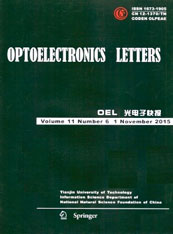
In this paper, we mainly study the preparation of an optical biosensor based on porous silicon (PSi) Bragg mirror and its feasibility for biological detection. The quantum dot (QD) labeled biotin was pipetted onto streptavidin functionalized PSi Bragg mirror samples, the affinity reaction between QD labeled biotin and streptavidin in PSi occurred, so the QDs were indirectly connected to the PSi. The fluorescence of QD enhanced the signal of biological reactions in PSi. The performance of the sensor is verified by detecting the fluorescence of the QD in PSi. Due to the fluorescence intensity of the QDs can be enhanced by PSi Bragg mirror, the sensitivity of the PSi optical biosensor will be improved.
Tm3+doped Na5Lu9F32single crystal with high optical quality was grown by an improved Bridgman method. The Judd-Ofelt intensity parameters Ωt(t=2, 4, 6) were calculated according to the measured absorption spectra and physical- chemical properties of the obtained Na5Lu9F32single crystal. The stimulated emission cross-section of the 3F4→3H6transition (~1.8 μm) is 0.35×10-20cm2for Tm3+doped Na5Lu9F32single crystal. The emission spectra under the excitation of 790 nm laser diode (LD) and fluorescence lifetime at 1.8 μm were measured to reveal the fluorescence properties of Tm3+doped Na5Lu9F32single crystal. The research results show that the Tm3+doped Na5Lu9F32single crystal has larger stimulated emission cross-section compared with other crystals. All these spectral properties suggest that this kind of Tm3+doped Na5Lu9F32crystal with high physical-chemical stability and high-efficiency emission at 1.8 μm may be used as potential laser materials for optical devices.








